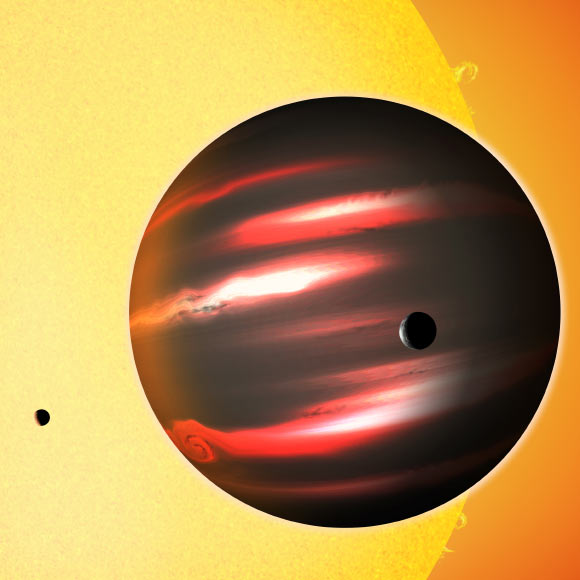Astronomers using data collected by NASA’s Kepler Space Telescope have found evidence of daily weather cycles on fourteen extrasolar gas giants.
“We determined the weather on these alien worlds (Kepler-5b, -6b, -7b, -8b, -10b, -12b, -41b, -43b, -76b, -91b, -412b, TrES-2b, HAT-P-7b and KOI-13b) by measuring changes as the planets circle their host stars, and identifying the day-night cycle. We traced each of them going through a cycle of phases in which different portions of the planet are illuminated by its star, from fully lit to completely dark,” said Lisa Esteves, a PhD candidate at the University of Toronto.
Most of the planets in the study are very hot and large, with temperatures greater than 1,600 degrees Celsius – conditions far from hospitable to life but excellent for phase measurements.
Among the findings are indications of cloudy mornings on Kepler-6b, Kepler-7b, Kepler-8b, Kepler-41b and hot, clear afternoons on two exoplanets, Kepler-76b and HAT-P-7b.
Because the planets are very near to their stars, they are expected to rotate counter-clockwise, with the right side moving in the direction of each exoplanet’s orbit. This causes an eastward movement of the exoplanet’s surface and therefore an eastward circulation of atmospheric winds.
As a result, clouds that form on the exoplanet’s night side, where temperatures are cooler while it faces away from its host star, would be blown to the morning side.
“As the winds continue to transport the clouds to the day side, they heat up and dissipate, leaving the afternoon sky cloud-free. These winds also push the hot air eastward from the meridian, where it is the middle of the day, resulting in higher temperatures in the afternoon,” said Esteves, who is the first author on the study published in the Astrophysical Journal (arXiv.org preprint).
For four of the planets, the astronomers saw excess brightness in the data that corresponds to when the morning side is visible. For the other two, they saw an excess when the evening side is visible.
“By comparing the planets’ previously determined temperatures to the phase cycle measurements provided by Kepler, we found that the excess brightness on the morning side is most likely generated by reflected starlight. These four planets are not hot enough to generate this excess light through thermal emission,” Esteves said.
“The excess light seen on the two very hot planets can be explained by thermal emission. A likely explanation is that on these two planets, the winds are moving heat towards the evening side, resulting in the excess brightness.”
Study co-author Ray Jayawardhana of York University added: “someday soon we hope to be talking about weather reports for alien worlds not much bigger than Earth, and to be making comparisons with our home planet.”
_____
Lisa J. Esteves et al. 2015. Changing Phases of Alien Worlds: Probing Atmospheres of Kepler Planets with High-precision Photometry. ApJ 804, 150; doi: 10.1088/0004-637X/804/2/150








